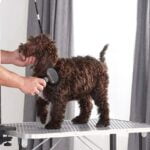Table of Contents
Teaching your dog to come when called is an essential command for their safety and your peace of mind. A reliable recall can prevent accidents, keep your dog safe, and strengthen your bond. In this article, we provide 10 effective techniques on how to train a dog to come when called successfully.

Start with a Strong Foundation
Building a strong foundation is key in how to train a dog to come when called. Start with basic obedience commands such as sit, stay, and down. These commands help establish your role as the leader and build trust. For more on basic obedience, visit ASPCA Dog Training Tips.
Use Positive Reinforcement
Positive reinforcement is crucial in training your dog to come when called. Use treats, praise, and affection to reward your dog when they respond to your command. This creates a positive association with coming to you. For more on positive reinforcement, see Humane Society Positive Training.
Choose a Unique Command
Pick a unique command word for the recall, such as “come” or “here.” Use this command consistently and avoid using it in negative contexts. A distinct word helps your dog understand and respond better. For more on choosing commands, visit AKC Training Tips.
Practice in a Controlled Environment
Start training in a quiet, controlled environment with minimal distractions. Gradually increase the difficulty by introducing more distractions and practicing in different locations. For more on controlled environments, see Cesar’s Way Training Recall.
Use a Long Leash
Using a long leash allows your dog some freedom while still giving you control. Practice the recall command and gently guide your dog back to you if needed. This helps reinforce the behavior. For more on leash training, visit PetMD Leash Training.
Be Consistent
Consistency is key in how to train a dog to come when called. Use the same command, tone, and reward every time. Consistent training helps your dog understand and remember the command. For more on consistency, see Kennel Club Training Tips.
Make It Fun
Turn the recall training into a fun game. Play hide and seek, or run away and call your dog to come find you. Making training enjoyable keeps your dog engaged and eager to respond. For more fun training ideas, visit The Spruce Pets Fun Training.
Gradually Increase Distance
As your dog becomes more reliable, gradually increase the distance from which you call them. Start with short distances and slowly work up to longer ones. This helps build a strong recall at any range. For more on distance training, visit Vetstreet Recall Training.
Reward Every Time
Always reward your dog when they come to you, even if it takes a while. Avoid punishment or negative reactions, as this can create a negative association with the command. For more on rewarding your dog, see Dogs Trust Training Tips.
Practice Regularly
Regular practice is essential to maintain a strong recall. Incorporate recall training into your daily routine and keep sessions short and positive. Consistent practice reinforces the behavior. For more on practice routines, visit Clicker Training Recall Tips.
Conclusion
Learning how to train a dog to come when called is essential for their safety and your peace of mind. By following these 10 effective techniques, you can achieve a reliable recall and strengthen your bond with your dog. Remember to be patient, consistent, and positive throughout the training process. For more tips on dog training and behavior, check out our Dog Training Guide.
FAQs on How to Train a Dog to Come When Called
What should I do if my dog doesn’t come when called?
If your dog doesn’t come when called, avoid punishment. Instead, go back to basics, use a long leash for guidance, and increase the value of rewards.
How long does it take to train a dog to come when called?
The time it takes varies depending on the dog, consistency, and training methods. With regular practice, most dogs can learn a reliable recall within a few weeks.
Can older dogs learn to come when called?
Yes, older dogs can learn to come when called. The training principles are the same, though it may take a bit longer for older dogs to learn new commands.
Should I use a clicker for recall training?
Using a clicker can be beneficial for recall training as it provides a clear and consistent marker for desired behavior. Pair the clicker with positive reinforcement for best results.
What if my dog gets distracted easily?
Start training in a controlled environment with minimal distractions. Gradually introduce distractions and increase the difficulty as your dog becomes more reliable with the recall command.
How can I reinforce recall training in everyday situations?
Incorporate recall training into your daily routine by calling your dog for meals, playtime, or treats. Regular practice in various situations helps reinforce the behavior.











